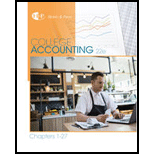
College Accounting, Chapters 1-27
23rd Edition
ISBN: 9781337794756
Author: HEINTZ, James A.
Publisher: Cengage Learning,
expand_more
expand_more
format_list_bulleted
Textbook Question
Chapter 2, Problem 3TF
According to the business entity concept, nonbusiness assets and liabilities are not included in the business’s accounting records.
Expert Solution & Answer
Want to see the full answer?
Check out a sample textbook solution
Students have asked these similar questions
Please given step by step explanation general Accounting question
Give me Answer of this financial accounting question ?
Suppose the required reserve retio of solve this question
Chapter 2 Solutions
College Accounting, Chapters 1-27
Ch. 2 - Prob. 1TFCh. 2 - Accounts Payable is an example of an asset...Ch. 2 - According to the business entity concept,...Ch. 2 - The accounting equation (Assets = Liabilities +...Ch. 2 - When an asset increases, a liability must also...Ch. 2 - Expenses represent outflows of assets or increases...Ch. 2 - When total revenues exceed total expenses, the...Ch. 2 - An increase to which of these accounts will...Ch. 2 - When delivery revenue is earned in cash, which...Ch. 2 - When delivery revenue is earned on account, which...
Ch. 2 - When payment is made on an existing debt, which...Ch. 2 - Which of the following accounts does not appear on...Ch. 2 - Checkpoint Exercises Label each of the following...Ch. 2 - What is missing from the accounting equation...Ch. 2 - What are the effects of the following transactions...Ch. 2 - Classify the following accounts as assets (A),...Ch. 2 - Name and define the six major elements of the...Ch. 2 - Name and define the six major elements of the...Ch. 2 - List the three basic questions that must be...Ch. 2 - Prob. 4RQCh. 2 - Prob. 5RQCh. 2 - Prob. 6RQCh. 2 - What are the three basic phases of the accounting...Ch. 2 - SERIES A EXERCISES ACCOUNTING ELE MENT S Label...Ch. 2 - Prob. 2SEACh. 2 - Assets following (d): 32,200 EFFECTS OF...Ch. 2 - EFFECTS OF TRANSACTIONS (BALANCE SHEET ACCOUNTS)...Ch. 2 - FINANCIAL STATEMENT ACCOUNTS Label each of the...Ch. 2 - STATEMENT OF OWNERS EQUITY REPORTING NET INCOME...Ch. 2 - STATEMENT OF OWNERS EQUITY REPORTING NET INCOME...Ch. 2 - SERIES A PROBLEMS THE ACCOUNTING EQUATION Dr. John...Ch. 2 - EFFECT OF TRANSACTIONS ON ACCOUNTING EQUATION Jay...Ch. 2 - EFFECT OF TRANSACTIONS ON ACCOUNTING EQUATION Jay...Ch. 2 - EFFECT OF TRANSACTIONS ON ACCOUNTING EQUATION Jay...Ch. 2 - EFFECT OF TRANSACTIONS ON ACCOUNTING EQUATION Jay...Ch. 2 - ACCOUNTING ELEMENTS Label each of the following...Ch. 2 - THE ACCOUNTING EQUATION Using the accounting...Ch. 2 - EFFECTS OF TRANSACTIONS (BALANCE SHEET ACCOUNTS)...Ch. 2 - EFFECTS OF TRANSACTIONS (BALANCE SHEET ACCOUNTS)...Ch. 2 - FINANCIAL STATEMENT ACCOUNTS Label each of the...Ch. 2 - STATEMENT OF OWNERS EQUITY REPORTING NET INCOME...Ch. 2 - STATEMENT OF OWNERS EQUITY REPORTING NET LOSS...Ch. 2 - SERIES B PROBLEMS THE ACCOUNTING EQUATION Dr....Ch. 2 - EFFECT OF TRANSACTIONS ON ACCOUNTING EQUATION...Ch. 2 - EFFECT OF TRANSACTIONS ON ACCOUNTING EQUATION...Ch. 2 - STATEMENT OF OWNERS EQUITY Based on Problem 2-9B,...Ch. 2 - BALANCE SHEET Based on Problem 2-9B, prepare a...Ch. 2 - Prob. 1MYWCh. 2 - Prob. 1MPCh. 2 - CHALLENGE PROBLEM In this chapter, you learned...
Knowledge Booster
Learn more about
Need a deep-dive on the concept behind this application? Look no further. Learn more about this topic, accounting and related others by exploring similar questions and additional content below.Similar questions
- Provide correct option with calculation step by steparrow_forwardaccounts age of period ?arrow_forwardJackson Manufacturing applies overhead using a normal costing approach based on machine-hours. Budgeted factory overhead was $312,000, and budgeted machine-hours were 20,800. Actual factory overhead was $330,480, and actual machine-hours were 21,400. How much is the over- or underapplied overhead? Answerarrow_forward
- Saffron Industries had their total liabilities increased by $7,300 and stockholders' equity decreased by $4,200 during a period of time. Then total assets must have changed by what amount and direction during that same period?helparrow_forwardFind turnover and average total assetsarrow_forwardJackson Manufacturing applies overhead using a normal costing approach based on machine-hours. Budgeted factory overhead was $312,000, and budgeted machine-hours were 20,800. Actual factory overhead was $330,480, and actual machine-hours were 21,400. How much is the over- or underapplied overhead?arrow_forward
- average total assets.arrow_forwardBradley Industries applies manufacturing overhead on the basis of direct labor-hours. At the beginning of the most recent year, the company based its predetermined overhead rate on total estimated overhead of $245,000 and 7,000 estimated direct labor-hours. Actual manufacturing overhead for the year amounted to $243,500, and actual direct labor-hours were 6,950. The applied manufacturing overhead for the year was closest to __.arrow_forwardFind operating cash flowarrow_forward
arrow_back_ios
SEE MORE QUESTIONS
arrow_forward_ios
Recommended textbooks for you
 College Accounting, Chapters 1-27AccountingISBN:9781337794756Author:HEINTZ, James A.Publisher:Cengage Learning,Principles of Accounting Volume 2AccountingISBN:9781947172609Author:OpenStaxPublisher:OpenStax College
College Accounting, Chapters 1-27AccountingISBN:9781337794756Author:HEINTZ, James A.Publisher:Cengage Learning,Principles of Accounting Volume 2AccountingISBN:9781947172609Author:OpenStaxPublisher:OpenStax College College Accounting (Book Only): A Career ApproachAccountingISBN:9781337280570Author:Scott, Cathy J.Publisher:South-Western College Pub
College Accounting (Book Only): A Career ApproachAccountingISBN:9781337280570Author:Scott, Cathy J.Publisher:South-Western College Pub Cornerstones of Financial AccountingAccountingISBN:9781337690881Author:Jay Rich, Jeff JonesPublisher:Cengage Learning
Cornerstones of Financial AccountingAccountingISBN:9781337690881Author:Jay Rich, Jeff JonesPublisher:Cengage Learning

College Accounting, Chapters 1-27
Accounting
ISBN:9781337794756
Author:HEINTZ, James A.
Publisher:Cengage Learning,

Principles of Accounting Volume 2
Accounting
ISBN:9781947172609
Author:OpenStax
Publisher:OpenStax College

College Accounting (Book Only): A Career Approach
Accounting
ISBN:9781337280570
Author:Scott, Cathy J.
Publisher:South-Western College Pub


Cornerstones of Financial Accounting
Accounting
ISBN:9781337690881
Author:Jay Rich, Jeff Jones
Publisher:Cengage Learning

ACCOUNTING BASICS: Debits and Credits Explained; Author: Accounting Stuff;https://www.youtube.com/watch?v=VhwZ9t2b3Zk;License: Standard Youtube License